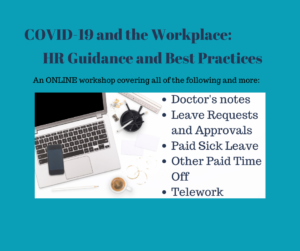Whoa! The world as we know it has dramatically shifted in the last 72-hours. Most of us went from thinking that the panic over toilet paper was ridiculous and wondering how the COVID-19/Coronavirus may impact us to having our children home from school, worrying about our parents and/or grandparents and wondering what steps we can take to protect ourselves and our businesses. Here’s what you need to know to manage the pandemic as you manage your business.

There’s some specific health information that it is critical that businesses know and share with their employees. See the links below.
HR Best Practices
There are also some critical HR Best Practices that you should put into place.
- First, if employees aren’t feeling well, send them home.
- Allow liberal leave policies. If you have a point system, suspend it for the duration of the recommended quarantine.
- Employees may use their paid sick leave and other paid time off during this time.
- Set up a system for employees to work from home, if possible.
- Encourage employees to follow the recommended quarantine protocols to the best of their ability.
- Clean shared surfaces regularly and allow the disinfectant to sit on the surface and air dry.
- Help manage the pandemic by managing emotions. Encourage employees to stay focused on the tasks at hand and not spiral into fear and panic.
Telework/Working from Home
If you’ve never set up a telework option before, take into consideration the following as you manage the pandemic from the viewpoint of your business:
- What positions are “essential personnel” whose roles do not allow them to work from home?
- You may need to move from a voluntary option to a mandatory option depending on what occurs with the pandemic.
- One key for supervisors and managers is to trust your employees. Yeah, they might throw a load of laundry in the machine while “on company time” but how many cat videos did they share while in the office? It’s easy to assume that employees are wasting time when we can’t see what they’re doing. But studies show that employees who telework are more productive than those who are interrupted by co-workers. Assume the best during this time.
- Whose equipment will be used? Company-provided or employee-provided?
- Do you already have some type of conferencing system that you can use to hold meetings/video calls? How will everyone connect with each other? Who needs to be connected with each other? How will you manage the connections?
- What do you need to do to manage customer expectations during this time? Most customers will be reasonable because obviously everyone is aware that the pandemic is going on. However, what do you need to communicate to them about your current staffing and how will you do that?
- Do you require any type of additional internet security? Are there any steps employees need to take to keep proprietary information safe?
- How will employees keep track of their time?
- Will employees be able to work full-time if other members of their family are also at home? Or would working part-time be a better option?
- Encourage employees to consider where they are working and what they need to do to maintain safety while at home. (Keep in mind workers’ compensation covers employee injuries if they are doing work. The location of the work isn’t a factor in whether a claim is covered or not. Report and submit all claims as soon as possible.)
- How will employees get any office supplies that they need to work from home? Will someone in the office mobile order and have them shipped to their home? Will someone deliver them or will employees stop by the office and pick them up?
Review these 4 resources regularly as they will be updated as more information become available:
CalOsha guidance to protect workers – specific to the health care industry can be found here.
And for non-health care industry, it is here.
FAQ on California’s Labor Commissioner’s office regulatory enforcement around businesses handling employees who may have the Coronavirus or traveled to/from a high-risk area can be found here.
CDC’s interim guidance for businesses and employers: Plan, prepare and respond to the Coronavirus 2019. Find it here.
